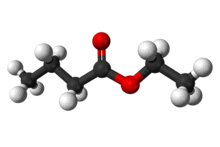 | |
 | |
| Names | |
|---|---|
| Preferred IUPAC name Ethyl butanoate | |
| Other names Butanoic acid methyl ester Ethyl butyrate Butyric acid ethyl ester Ethyl n-butanoate Ethyl n-butyrate Butyric ether UN 1180 | |
| Identifiers | |
3D model (JSmol) | |
| ChEBI | |
| ChEMBL | |
| ChemSpider | |
| ECHA InfoCard | 100.003.007 |
| EC Number |
|
PubChem CID | |
| UNII | |
CompTox Dashboard (EPA) | |
| |
SMILES
| |
| Properties[1] | |
Chemical formula | C6H12O2 |
| Molar mass | 116.160 g·mol−1 |
| Appearance | Colorless liquid with fruity odor (typically pineapple) |
| Density | 0.879 g/cm3 |
| Melting point | −93 °C (−135 °F; 180 K) |
| Boiling point | 120–121 °C (248–250 °F; 393–394 K) |
| Soluble in 150 parts | |
| Vapor pressure | 1510 Pa (11.3 mmHg) |
| −77.7×10−6 cm3/mol | |
| Hazards | |
| Main hazards | Irritant (Xi) |
| Safety data sheet | See: data page |
| R-phrases (outdated) | R10 R36/37/38 |
| S-phrases (outdated) | S16 S26 S36 |
| NFPA 704 (fire diamond) | |
| Flash point | 26 °C; 78 °F; 299 K c.c. |
Autoignition temperature | 463 °C (865 °F; 736 K) |
| Lethal dose or concentration (LD, LC): | |
LD50 (median dose) | 13050 mg/kg (oral, rat)[1] |
| Supplementary data page | |
Structure and properties | Refractive index (n), Dielectric constant (εr), etc. |
Thermodynamic data | Phase behaviour solid–liquid–gas |
Spectral data | UV, IR, NMR, MS |
Except where otherwise noted, data are given for materials in their standard state (at 25 °C [77 °F], 100 kPa). | |
Ethyl butyrate, also known as ethyl butanoate, or butyric ether, is an ester with the chemical formula CH3CH2CH2COOCH2CH3. It is soluble in propylene glycol, paraffin oil, and kerosene. It has a fruity odor, similar to pineapple, and is a key ingredient used as a flavor enhancer in processed orange juices.[1] It also occurs naturally in many fruits, albeit at lower concentrations.[2]
Uses
It is commonly used as artificial flavoring resembling orange juice[3] and is hence used in nearly all orange juices sold, including those sold as "fresh" or concentrated".[4] It is also used in alcoholic beverages (e.g. martinis, daiquiris etc.), as a solvent in perfumery products, and as a plasticizer for cellulose.
Ethyl butyrate is one of the most common chemicals used in flavors and fragrances. It can be used in a variety of flavors: orange (most common), cherry, pineapple, mango, guava, bubblegum, peach, apricot, fig, and plum. In industrial use, it is also one of the cheapest chemicals, which only adds to its popularity.
Production
It can be synthesized by reacting ethanol and butyric acid. This is a condensation reaction, meaning water is produced in the reaction as a byproduct. Ethyl butyrate from natural sources can be distinguished from synthetic ethyl butyrate by Stable Isotope Ratio Analysis (SIRA).[5]
Table of physical properties
| Property | Value |
|---|---|
| Critical temperature (Tc) | 296 °C (569 K) |
| Critical pressure (pc) | 3.10 MPa (30.64 bar) |
| Critical density (ρc) | 2.38 mol.l−1 |
| Refractive index (n) at 20 °C | 1.390 - 1.394 |
See also
References
- ^ a b c Merck Index, 12th Edition, 3822
- ^ Schieberle, H.-D. Belitz, W. Grosch, P. (2009). Food chemistry (4th rev. and extended ed.). Berlin: Springer. ISBN 9783540699330.
- ^ Andrea Walker (12 May 2009). "Ask an Academic: Orange Juice". The New Yorker.
- ^ Hamilton, Alissa. Squeezed. Yale University.
- ^ Ashurst, P.R.; Dennis, M.J. (1998). Analytical methods of food authentication (1st ed.). London: Blackie Academic & Professional. ISBN 9780751404265. Retrieved 27 January 2016.
